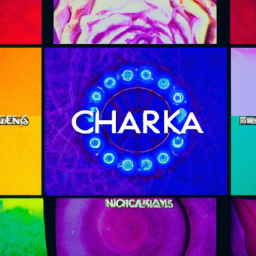?
Chakras are energy centers that exist within the subtle body. Derived from Sanskrit, the word “chakra” means ”wheel” or “circle”. These energy centers are believed to be responsible for distributing and regulating energy flow throughout the body, affecting our physical, emotional, and spiritual well-being.
While there are hundreds of chakras in the body, there are seven main chakras that are considered the most important and influential. They are often referred to as the body chakras, and each one is associated with a specific part of the body, as well as certain emotions and behaviors.
The Seven Main Chakras
Below is a brief overview of each of the seven main chakras and their corresponding location, color, emotion, and characteristics.
- Root Chakra (Muladhara) – Located at the base of the spine, this chakra is associated with the color red. It represents our foundation, stability, and sense of security.
- Sacral Chakra (Svadhishthana) – Located in the lower abdomen, this chakra is associated with the color orange. It represents our creativity, sexuality, and pleasure.
- Solar Plexus Chakra (Manipura) - Located in the upper abdomen, this chakra is associated with the color yellow. It represents our personal power, confidence, and self-esteem.
- Heart Chakra (Anahata) – Located in the center of the chest, this chakra is associated with the color green. It represents our ability to love, compassion, and forgiveness.
- Throat Chakra (Vishuddha) – Located in the throat, this chakra is associated with the color blue. It represents our communication, self-expression, and truth.
- Third Eye Chakra (Ajna) – Located in the center of the forehead, this chakra is associated with the color indigo. It represents our intuition, inner wisdom, and spiritual awareness.
- Crown Chakra (Sahasrara) – Located at the top of the head, this chakra is associated with the color violet or white. It represents our connection to the divine, spiritual enlightenment, and cosmic consciousness.
The Importance of Balance
In order for our physical, emotional, and spiritual bodies to function in harmony, it is essential for our chakras to be balanced. When a chakra is overactive, it can lead to an excess of energy in that particular area, causing physical or emotional imbalances. On the other hand, an underactive chakra can result in a deficiency of energy, which can also manifest in various ways.
For instance, if the heart chakra is overactive, it can lead to codependency and clinginess, while an underactive heart chakra can cause a person to feel distant and disconnected from others. Similarly, an overactive solar plexus chakra can lead to aggression and dominance, while an underactive one can result in feelings of insecurity and low self-esteem.
Therefore, it is important to maintain a balance of energy in each chakra to achieve optimal physical, mental, and emotional health.
How to Balance Your Chakras
There are many techniques and practices that can help balance your chakras, such as yoga, meditation, sound therapy, and crystal healing. However, the first step to balancing your chakras is to become aware of your energy centers and any imbalances that may exist.
Take the time to check-in with your body, mind, and emotions regularly. You can also use guided meditations or visualization techniques to focus on each chakra and balance its energy. Additionally, incorporating chakra-balancing foods, colors, and scents into your daily life can also help restore and maintain balance.
In Conclusion
Our body chakras play a crucial role in our overall well-being, affecting us on physical, emotional, and spiritual levels. By understanding and balancing these energy centers, we can achieve a sense of harmony, inner peace, and full alignment. So take some time to explore and nurture your chakras for a balanced and thriving life.





Fascinating, I never knew about this before!
JoanBond: I’m so excited to read and learn more – thank you for posting this!
This is so informative – the concept of chakras has always intrigued me!